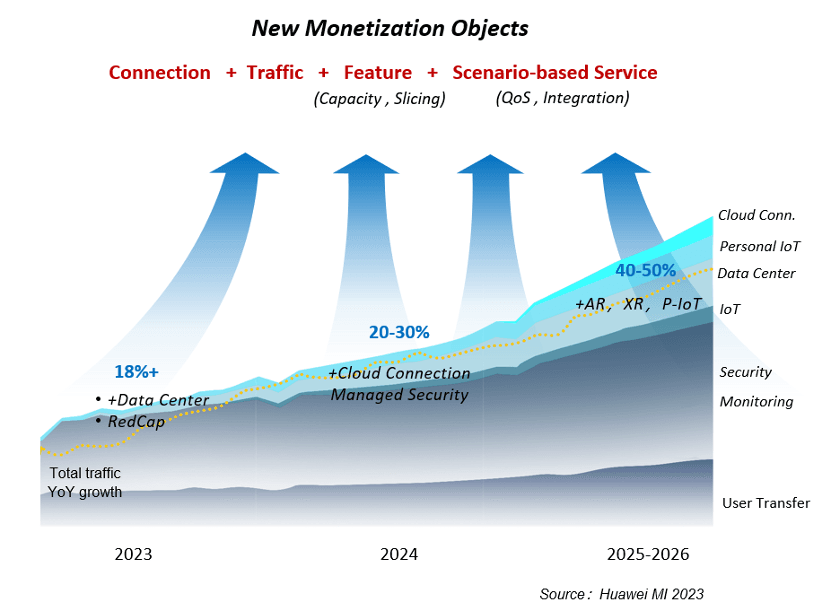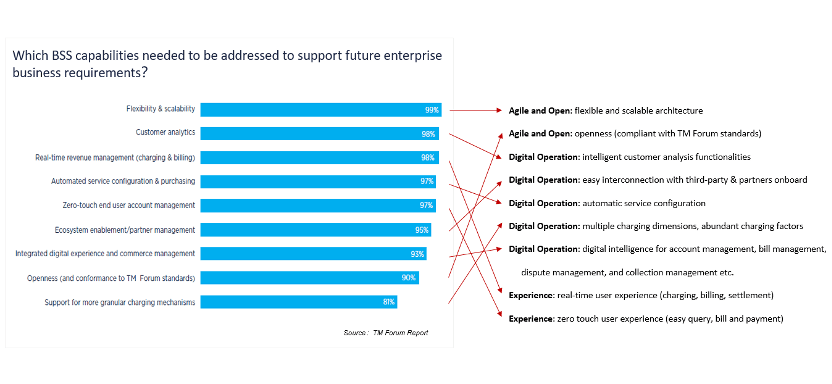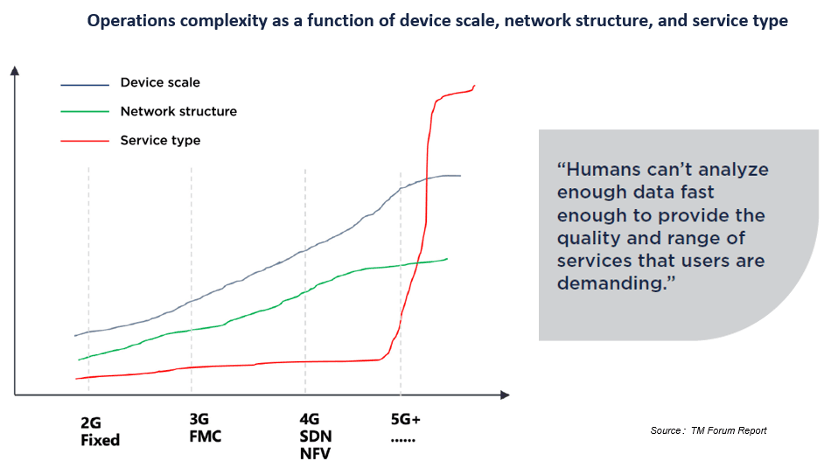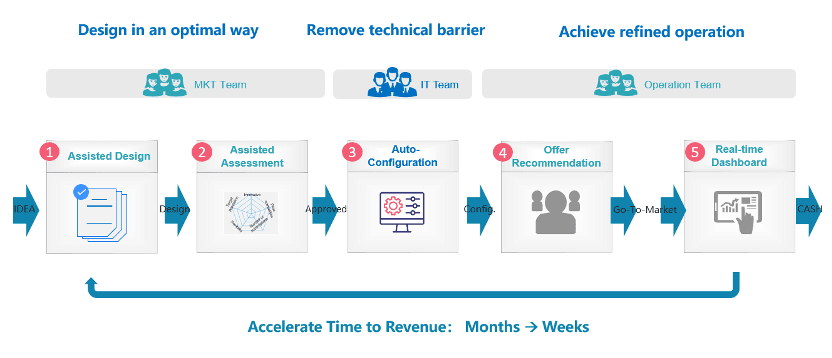Prospect of Monetization System in The Era of Intelligence
By: Jack Cao, Vice President of Huawei Software Domain, Huawei
At present, the telecom carrier market is in a highly competitive stage. On one hand, the demand of users for network services is increasing, as well as their requirements for improved service quality, improved network speed, and personalized services.
On the other hand, the emergence of new products and technologies, such as 5G, cloud computing, IoT, big data, AI, and autonomous driving brings new business opportunities as well as severe challenges to CSPs. CSPs compete not only in price and network coverage, but also in customer experience, TTM, 2B services, and value-added services. Enabling intelligent monetization in the digital era is now more crucial than ever.
1. CSPs are moving from the "connection + traffic" monetization model to the "connection + traffic + features + scenario-based services" model. Multi-dimension charging therefore becomes a key capability.

Even though "Connection + traffic" is still the cornerstone, however, outside the public market, such as the government and enterprise markets, CSPs’ monetization models will change significantly in the forthcoming years. In the government and enterprise markets, "connection + feature + scenario-based services" will become an important monetization model, and CSPs are trying to monetize their network to generate new revenue streams via introducing features (such as 5G slicing) and scenario-based services (such as cloud services, security services, industry solutions, partner resale, etc.).
Sooner or later, the legacy charging & billing system needs to be upgraded or reconstructed to support multi-dimension charging, including flexible interconnection with third-party systems and configurable capabilities, and to support the quick launch of new services and monetize CSPs’ assets.
2. Terms of Business (ToB) is widely recognized as the future path for CSPs' revenue growth and the main driving force for Billing modernization.
The 2C market is becoming saturated with users, while the 2B market is highly anticipated by CSPs. However, today's enterprise billing systems were originally designed to support connectivity services that were developed 10 to 20 years ago, and in some cases, they are even older. Moreover, state-owned telcos have been providing communications services to governments in their regions for more than 100 years.
These systems have only gradually been modernized, and modern enterprises are increasingly relying on new services based on new technologies such as 5G, IoT, and edge computing. Hence, the traditional enterprise billing system must be reconstructed to adapt to these changes. In addition, the 2B market is fragmented, with varying customer demands for charging, accounting, and billing. Today's enterprise users have higher requirements for flexibility, real-time accuracy, end-to-end service, and billing experience.
According to the TM Forum's questionnaire survey on the future 2B development of more than 200 CSP customers, most of them believe that the modern enterprise billing system needs to be improved completely in all the following aspects:

3. AI has become the focus of innovation. Embracing new technologies such as AI to accelerate system intelligence is an important means for precise operation, marketing revenue increase, and experience improvement.
The integration of AI into CSPs’ digital transformations is becoming increasingly important. According to the research report released by the TM Forum, the complexity of CSPs' service operations increased sharply in the 5G era.
The introduction of various new digital services, including self-service, and on-demand services as well as the emergence of new network types, such as dedicated networks for intelligent industrial applications, deterministic networks with SLA guarantee, and dynamic networks for balancing energy consumption and load, along with new boundaries of activity, such as openness to collaboration with partners, application developers, and so on, will greatly increase the complexity of business operations.
To adapt to these changes, CSPs must change the way they operate and maintain their services.

For example, when a new service offering is getting online in the current charging system, generally several processes are involved. These include offer design, offer evaluation, offer configuration, offer launch, offer campaign, and offer operation. The activities need to be carried out in collaboration with the marketing teams, engineering teams, and O&M teams, and usually, it takes more time than expected.
Some CSPs may take 5-6 months or even longer for a new service offer to launch from the point the marketing team has the offer design idea to the point when it starts market monetization. However, with Artificial Intelligence and Machine Learning, our charging system can intelligently support offer design, automatic offer evaluation, automatic offer configuration, and intelligent offer recommendation, and provide an intelligent, real-time, and customizable offer dashboard at the end of the process. In this way, the launch process can be shortened from 5-6 months to 3-4 weeks, greatly improving the operation efficiency and the collaboration between the different teams.

In the future, we believe that the next-generation monetization system must have the following features:
- Hyperscale Internet of Things (IoT) Billing: With the proliferation of IoT devices, the new monetization systems will need to adapt to the specific charging & billing needs of various devices.
- Open APIs and Ecosystem: By opening APIs and building an open ecosystem, the new monetization system will simplify the process for CSPs to generate revenue from their network asset and user assets.
- Cross-border Cooperation: Telecom CSPs may cooperate with service providers in other industries to provide cross-industry monetization solutions and integrate with other services and applications.
- Flexible Pricing Policies: The new monetization system supports more flexible pricing policies, including dynamic pricing, tiered pricing, and personalized pricing, to meet the requirements of different users and scenarios.
- Multi-channel Integration: The new monetization system will be integrated with various channels including mobile apps, social media, online platforms, etc. to provide a seamless user experience.
- Personalized, Automated Service Experience: The new monetization system will provide a personalized user interface and experience, enabling users to easily manage their accounts and services and reducing the need for human intervention through automated processes.
- AI / Machine Learning / Big Data Analytics: Technologies such as AI, machine learning, and big data analytics will be widely used in the new monetization system to predict user behavior, optimize pricing policies, and detect fraud.
- Security and Privacy Protection: The enhanced data protection laws and regulations will lead to a greater emphasis on ensuring the security and privacy of user data within the new monetization system.
- Blockchain Technology: Blockchain technology may be used in new monetization systems to improve transaction transparency, security, and efficiency.
- Cloud-native Architecture: Cloud-native, fully containerized, and microservice-based to provide higher scalability, flexibility, and cost-effectiveness.
To meet these challenges, it is imperative to reconstruct the traditional charging & billing system, especially the enterprise billing system.
Huawei Convergent Billing Solution (CBS) Highlights:
The next-generation intelligent and cloud-native convergent system, enables agile business operations, transitioning operators from the digital era to the intelligence and automation era.
- Multi-dimension Convergence: Convergence 3.0 – transforming towards omni-convergence
- All networks (2/3/4/5G SA, 5G SA add-on to legacy platform in three months),
- All business (2C/2B/2H/new business),
- Alll connections (people + things, IoT scale high-performance supporting billions of connections, real-time group sharing of up to one million subscribers, with up to 5000TPS concurrency),
- All functions (charging, billing, settlement) with an ‘all-in-one’ solution
- 5G and New Business Monetization Ready:
- Top 1 contribution (40%+) to 3GPP standards in the 5G monetization domain.
- Fast implementation of new charging scenarios and modes defined in 3GPP standards, that support business quick innovation, such as B2B2X.
- Fully Cloud-native:
- Full containerization for database and applications, capacity (including application and database) can be expanded in minutes.
- N-LIVE and all-active distributed disaster recovery solution improves reliability to 99.9999%.
- Bare-metal containers, improve hardware resource utilization by 50%.
- Cloud-agnostic and any cloud supported, such as AWS, GPC, and Huawei public cloud. Cross-cloud support cloud-premises synergy and cross-cloud quick migration.
- Full-stack is heterogeneous from non-cloud stack to cloud-native task helps carriers in their journey towards seamless and non-risk evolution.
-
SaaS & Multi-tenants: CBS SaaS service is available on the public cloud and is currently being utilized commercially in Europe, significantly optimizing Capex and Opex of CSPs.
-
Openness:
- Opens over 300 APIs and flexible orchestration capabilities, enabling partners.
- Provides enterprise self-service to help carriers unlock network potential and enable value symbiosis with partners.
- Intelligence – Intelligent technology is introduced in the E2E process:
- Smart Infrastructure: Dynamic infrastructure resource scheduling according to business tidal scheduling optimizes infrastructure resources by 15%;
Smart Delivery: Continuously improves the version release and delivery period through DevOps & CI/CD. New capabilities can be released in one day, and new feature deliveries can be performed in seven days. Automated testing is implemented, leveraging intelligence to analyze failed cases and generate test reports.
Smart Operation: By leveraging the capabilities of AI/ML, the system can assist operators with offer design, offer evaluation, offer auto-configuration, and offer recommendation, and enables DIY offer dashboard, significantly improving operation efficiency. With intelligent big data analysis, the system obtains the credit scores of end users, helping carriers perform precise credit control, smart dunning (debt collection), and smart dispute management.
Smart Maintenance: Agile O&M features, such as AI-based fault detection and troubleshooting, auto self-healing/downgrade, and automatic scaling, greatly improves O&M efficiency.
By the end of 2023, Huawei CBS has been put into commercial use by more than 200 CSPs in more than 110 countries, serving 2.4 billion users.
